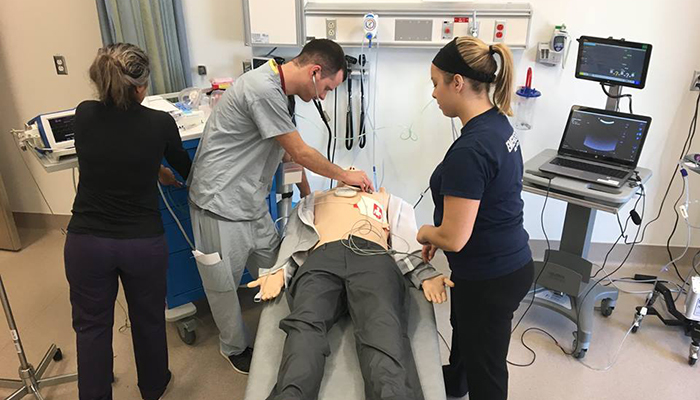New partnership for simulation in Niagara

Physicians, medical residents and students, nurses and educators received hands-on patient care experiences last Wednesday during a simulation open house at the St. Catharines site of Niagara Health. The use of medical simulation for education to improve patient safety using shared resources and expertise is behind a new partnership between Niagara Health and the Niagara Regional Campus of McMaster University's Michael G. DeGroote School of Medicine.
Physicians, medical residents and students, nurses and educators received hands-on patient care experiences last Wednesday during a simulation open house at the St. Catharines site of Niagara Health.
The use of medical simulation for education to improve patient safety using shared resources and expertise is behind a new partnership between Niagara Health and the Niagara Regional Campus of McMaster University’s Michael G. DeGroote School of Medicine.
The Development & Education in Simulation Interprofessional Group of Niagara (DESIGN) fosters safe spaces for learning.
“The DESIGN program first started as an initiative from McMaster’s Niagara Regional Campus here in St. Catharines, but it has now turned into a collaboration between McMaster University and Niagara Health,” said Dr. James Beecroft, who is the lead for simulation at the Niagara Regional Campus and a physician with Niagara Health’s Emergency Department.
“The educators, physicians, respiratory therapists and students involved mirrored that collaboration.”
During Wednesday’s events, a keynote speech was delivered by Matthew Sibbald, Director of McMaster University’s Centre for Simulation Based Learning (CSBL). Sibbald is an Assistant Professor at McMaster University for the Undergraduate MD program and the postgraduate Cardiology residency program. He is an interventional Cardiologist at Hamilton Health Sciences and Niagara Health.
Matthew Sibbald, director of McMaster University’s Centre for Simulation Based Learning (CSBL), gave a keynote talk about the “safe mistakes” of simulation.
He highlighted the importance of creating a safe space to learn and practice.
“This is our opportunity to be away from patients and learn as a group or as individuals. Simulation is another experience with one advantage, we can engineer the experience. We have to recognize that it won’t feel real all of the time, but we need to think about how we can transfer the experience to our patients as healthcare professionals,” said Sibbald.
The open house was with medical learners from the Niagara Regional Campus who were practising interprofessional simulations with Niagara Health professionals.
“This partnership demonstrates the commitment of the campus and of Niagara Health to a continued investment in resources that will improve patient safety and outcomes, and we welcome opportunities for shared learning and training resources,” said Amanda Bell, regional assistant dean of the Niagara Regional Campus.
Scenarios that were demonstrated in this open house included full resuscitations on a realistic mannequin simulating a patient with a burst aortic aneurysm who was critically ill. Participants also saw a simple task trainer that was used for students to learn how to insert central lines into a patient’s neck.
In a complex demonstration, a child-sized mannequin was used to represent a child with severe infection who was rapidly declining. During this simulation, the team also used a new video conference technology to communicate with the McMaster Children’s Hospital while resuscitating the patient.
“Simulation is being increasingly recognized as an important tool in the training of current and future healthcare providers,” said Bell. “Having the equipment and expertise in simulation available to us locally will improve learning opportunities for our students and the professional development offerings for staff at Niagara Health.”
News Article